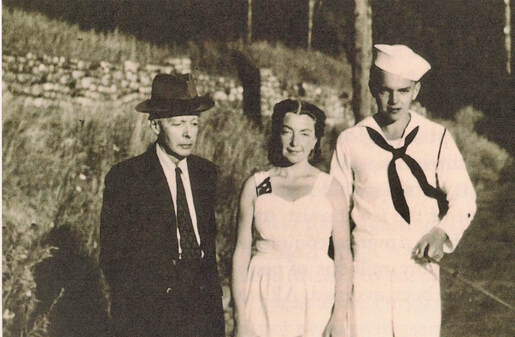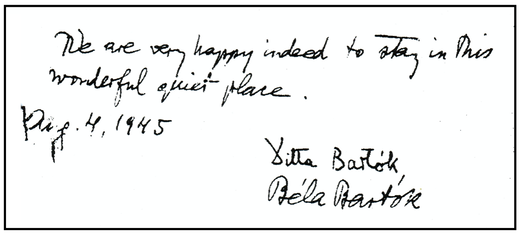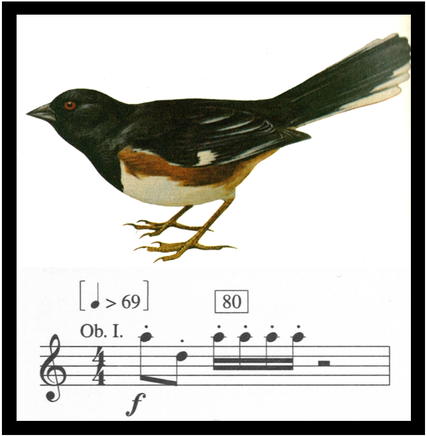|
by Amy Catania "I have been so upset by world events that my mind has been almost completely paralyzed.” — Béla Bartók In the midst of the dark days of World War II, a frail man named Béla Bartók came to Saranac Lake for his health. Although he was one of the greatest composers in human history, many Saranac Lakers might have seen him as just another invalid, tiny and pale, wrapped in his dark cape against the cold Adirondack weather. Bartók and his second wife Ditta fled their native Hungary eighty years ago, as fascism and antisemitism swept across Europe. He had dedicated his life not only to composing, but also collecting and arranging the folk music of Eastern Europe. Nazi Germany was threatening to erase the cultures of the Roma and other peasant peoples of the region. In the face of such terror, Bartók was depressed, impoverished, and sick with a form of leukemia that acted like tuberculosis. He and his wife moved from one cramped, loud, New York City apartment to another. He had ceased composing. In the summer of 1943, the Bartóks found refuge in Saranac Lake. Here, wrote his son Peter, "he found the peace and tranquility suitable for composing…. My father was obviously contented; his surroundings were as spartan as the interior of a Hungarian peasant cottage -- a reminder of a world with such fond associations for him.” Bartók spent three summers in Saranac Lake, where the quiet and natural environment inspired some of his greatest works — the Concerto for Orchestra, the Viola Concerto, and the Third Piano Concerto. In his music, he integrated peasant melodies of Eastern Europe with the birdsong of the Adirondacks. Here, under the cloud of terrible world events, he found a measure of hope. The cabin off of Riverside Drive, where Bartók stayed the last summer of his life in 1945, was saved from demolition thanks to a Romanian pianist named Cristina Stanescu. She had come to Saranac Lake to perform with the Gregg Smith Singers one summer some thirty years ago. While staying at Fogarty’s Bed and Breakfast, she learned about the decrepit cabin down the street where Bartók once stayed. The composer was a hero to Cristina. When she was just six years old, her first teacher in Romania had taught her Bartók’s music even though it was banned under Communism. To Christina’s teacher, Bartók represented friendship among the peoples of Eastern Europe, and his modernist compositions had become a symbol in Europe of anti-fascist resistance.
Cristina Stanescu raised the alarm to save the cabin. Emily Fogarty, Mary Hotaling, George Pappastavrou, Lex Dashnaw, and Doug March took up the cause, and they worked with a team of volunteers and musicians to raise the funds to save the cabin. Today Historic Saranac Lake provides tours of the Bartók Cabin in the summers, and many interesting people from around the world visit each year. One recent visitor to the cabin was Brian Ward. His grandmother, Corneila Hamvas, fled from the Nazis to the United States with her Jewish family. Back in Budapest, when Cornelia was seven years old, Béla Bartók taught her how to play the piano. This fall, standing in the humble cabin with Cornelia’s grandson, the past felt very close at hand. We listened for Bartók’s birds, calling in the woods. “My own idea… is the brotherhood of peoples, brotherhood in spite of wars and conflicts, I try -- to the best of my ability -- to serve this idea in my music; therefore, I don't reject any influence, be it Slovakian, Romanian, Arabic, or from any other source.” — Béla Bartók
1 Comment
Mato Ray
3/28/2022 08:55:02 am
Reply
Your comment will be posted after it is approved.
Leave a Reply. |
About us
Stay up to date on all the news and happenings from Historic Saranac Lake at the Saranac Laboratory Museum! Archives
August 2022
Categories
All
|
Historic Saranac Lake at the Saranac Laboratory Museum
89 Church Street, Suite 2, Saranac Lake, New York 12983
(518) 891-4606 - [email protected]
89 Church Street, Suite 2, Saranac Lake, New York 12983
(518) 891-4606 - [email protected]

Historic Saranac Lake is funded in part by the New York State Council on the Arts with the support of the Office of the Governor and the New York State Legislature,
and an Essex County Arts Council Cultural Assistance Program Grant supported by the Essex County Board of Supervisors.
and an Essex County Arts Council Cultural Assistance Program Grant supported by the Essex County Board of Supervisors.
© 2023 Historic Saranac Lake. All Rights Reserved. Historic photographs from Historic Saranac Lake Collection, unless otherwise noted. Copy and reuse restrictions apply.




 RSS Feed
RSS Feed